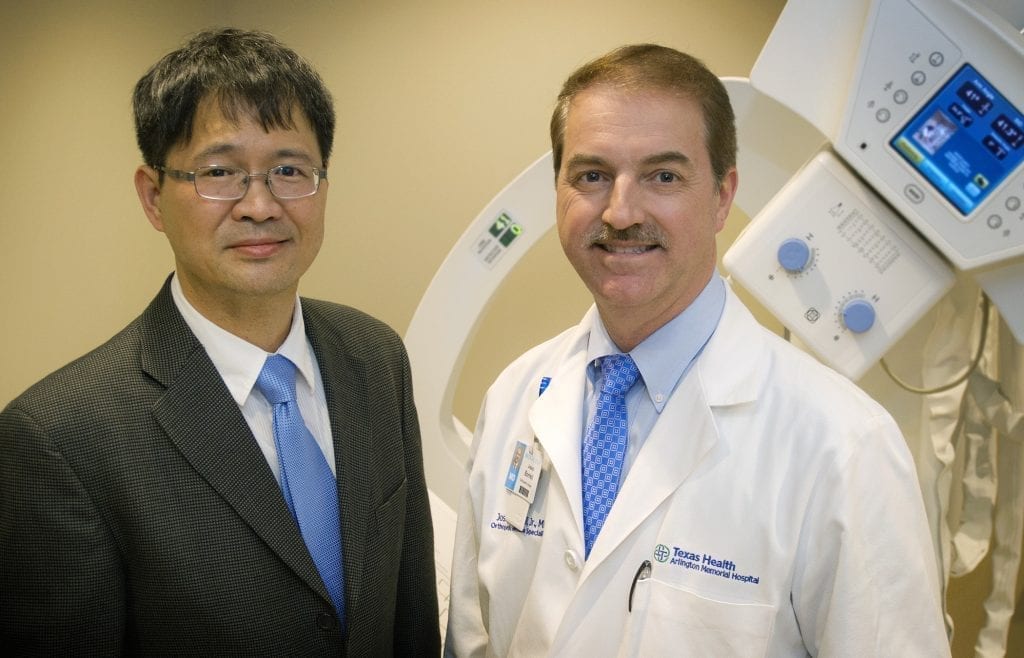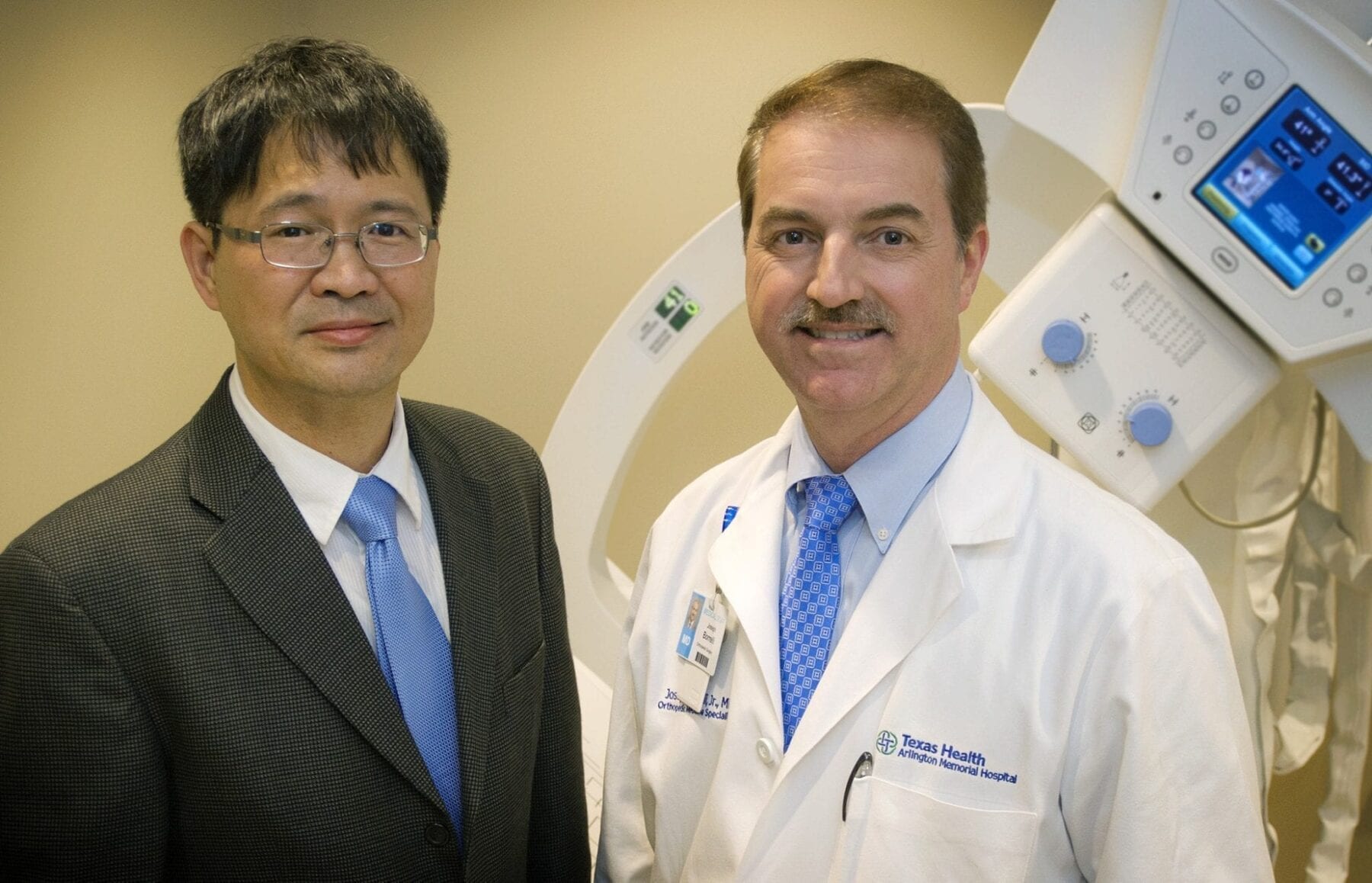
UT Arlington and Texas Health Arlington Memorial Hospital are investigating whether bone grown from the body’s own stem cells can replace traditional types of bone grafting.
The process, which has been successful in previous lab experiments, uses biodegradable polymer scaffolding material and bone morphogenetic protein, or BMP, which was inserted into the abdomen of mice to attract stem cells that in turn produced bone. BMPs are proteins known to promote bone growth. The research is detailed in a new paper, “Tissue Engineering Bone Using Autologous Progenitor Cells in the Peritoneum,” published by the online journal PLoS One.
Liping Tang, UT Arlington bioengineering chair and professor, and Dr. Joseph Borrelli, chair of orthopedics for Texas Health Arlington Memorial, co-authored the paper and are lead investigators of the research project.
Tang said the process will allow surgeons to establish a “mini-bioreactor” in a patient’s own body. Scientists determined that the abdomen of a mouse effectively mimics the traumatic and foreign body environmental response that takes place during various bone repair procedures in humans. Bone tissue can be generated in a few days through the process, he said, rather than the weeks or months existing processes take in a lab setting.
“This research will help us to formalize a specific type of scaffolding mixture that could eliminate the use of current bone grafting techniques,” Borrelli said.
The procedure could help with open bone fractures, osteomyelitis, fractures that fail to heal, congenital malformations, tumors and, in a more general sense, perhaps osteoporosis.
The goal is to use the body’s own healing capacity in bone repair, Borrelli said. For instance, today if a patient suffers from a bone defect or complex tibia fracture, a surgeon may perform an iliac crest bone graft, taking bone from the pelvis.
During the bone graft procedure, the surgeon uses a mechanism that scrapes or shaves bone from the pelvis. The bone shavings are then placed directly into the defect or combined with other proteins. If successful, the research involving Borrelli and Tang will eliminate the grafting technique altogether.
Borrelli said the current grafting procedure has a 25 percent complication rate. He said the new procedure will help curtail the complication rate associated with bone grafting and reduce medical costs.
“In the future, a physician will be able to inject the scaffolding material with the ideal protein into the area where the patient’s bone needs to grow or repair, and the patient’s cells will never have to leave the body,” Borelli said. “It will cut down on cost. It will cut down on surgery time. It will enhance patient comfort, too.”
Khosrow Behbehani, dean of the UT Arlington College of Engineering, said the collaboration between the hospital and the university is the kind of collaboration that can lead to innovation in health care.
“Partners like Texas Health Arlington Memorial keep our researchers focused on goals that will help people,” Behbehani said. “The work by Dr. Tang and Dr. Borrelli holds the promise of a medical advancement that can save patients time and money and improve treatment.”
The research team said the process could become an outpatient procedure in the future.
The Latest on: Bone tissue generation
[google_news title=”” keyword=”Bone tissue generation” num_posts=”10″ blurb_length=”0″ show_thumb=”left”]
via Google News
The Latest on: Bone tissue generation
- Biomolecular Atlas for Bone Marrow to Offer Unprecedented Window into Blood Productionon May 6, 2024 at 12:24 pm
Researchers at Children's Hospital of Philadelphia (CHOP) and the Perelman School of Medicine at the University of Pennsylvania revealed a powerful new bone marrow atlas that will offer the public a ...
- Steroids for Sale Unveils the Top 7 Supplements for Bodybuilders in 2024on May 6, 2024 at 4:54 am
Steroids for Sale, a leading provider of premium-grade supplements, announce the release of its highly anticipated lineup of top 7 steroids for bodybuilders and fitness enthusiasts in 2024. With a ...
- Plastics Hall of Fame 2024: Cato Laurencinon May 5, 2024 at 2:00 pm
A physician as well as a plastics expert, Cato Laurencin has develooped new technology combining polymers with health care needs.
- NGS and ctDNA Considered in Advanced Breast Cancer After Progressionon May 3, 2024 at 2:00 pm
During a Case-Based Roundtable® event, Ruth M. O'Regan, MD, led a discussion on whether to order next-generation sequencing and/or circulating tumor DNA testing for a patient with hormone ...
- Massage guns can do more harm than good if used improperly — here’s how to use themon May 2, 2024 at 10:08 am
Whether you exercise regularly and are looking for ways to help with your post-workout recovery or are experiencing newfound back pain due to a less-than-ideal desk setup, it might be time to invest ...
- FDA Clears Prime Medicine’s IND for First Prime Editing Therapyon April 29, 2024 at 5:00 pm
“We are thrilled to achieve this important milestone for our first product candidate, PM359, which represents the first-ever IND clearance for a Prime Editor product candidate and a significant ...
- Could a self-sustaining starship carry humanity to distant worlds?on April 7, 2024 at 8:59 am
Generation ships offer a tantalizing possibility ... Remarkably, they’re able to maintain their bone density and muscle mass. Part of their hibernation trick seems to come from turning down ...
- ‘New way of thinking’: Chinese researchers unveil unique strategy for tissue regeneration, functionon April 2, 2024 at 2:23 am
This new generation of neural construct implants - made of neural stem cells and inorganic biomaterials - was able to repair injured tissue and bone in rats with the guidance of nerves.
- Bone & Soft Tissueon October 3, 2020 at 10:45 pm
FISH and next-generation sequencing. Resident and fellow education is also an essential component of this service. UAB offers a one-year fellowship in diagnostic Surgical Pathology, the fellows of ...
- A new 3D-printed bone scaffold for major self-repairon February 24, 2020 at 3:49 pm
Professor Hala Zreiqat is printing bone substitutes at the University of Sydney’s Biomaterials and Tissue Engineering ... designed to promote bone generation. The non-toxic ceramic is porous ...
via Bing News











